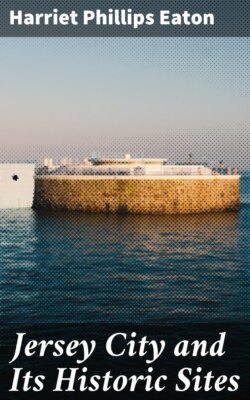Читать книгу Jersey City and Its Historic Sites - Harriet Phillips Eaton - Страница 7
На сайте Литреса книга снята с продажи.
COMMUNIPAW.
ОглавлениеTable of Contents
On September 8th, 1660, Jaques Cortelyou was ordered to survey Gemoenepa and lay it out into village lots. The village site fronted on the Bay, was two hundred feet deep and extended from what is now Communipaw avenue on the north to the Bay Shore House on the south. The Council ordered that the village should be stockaded, but there seems to have been numerous delays, for in June, 1663, Gerrit Gerritsen, Harman Smeeman and Dirck Claussen were appointed commissioners to fortify Gemoenepa. May 9th, 1661, Egbert Sandersen and Jan Theunissen, inhabitants of Midwout and Amersfoort, L. I., petitioned for leave to erect a saw-mill on a stream at Gemoenepa and move their families there and for a lot of land for each. The request was granted and probably they erected a mill below the Point of Rocks on the stream formerly called the Creek of the Woods and "Creek of the High Woodlands." In papers of 1671, the mill is mentioned as the "Mill of Hossemus;" probably from this mill the creek received its name of Mill Creek. Later Priors Mill was built upon this site and remained until removed and the creek filled in when the cut was made for the Pennsylvania railroad in 1837. In October, 1661, Sandersen asked permission to erect a saw-mill on Showhank Brook; this creek had its rise in an Indian spring in West Hoboken; it ran south until it reached the point where New York avenue crosses Palisade avenue; thence it turned down the hill through a wild ravine and emptied into Mill Creek. There was a saw-mill on this stream at the foot of the hill, until it was destroyed by fire in 1835.
The first legalized ferry across to Manhattan Island was established at the foot of Communipaw avenue when the village of Bergen was started in the fall of 1660 by William Jansen. The boats were periaugers, the old Spanish pirouge, pointed at both ends, with two masts, but no bowsprit. When horses and carriages were to be transported they were detached and lifted into the boat. The Governor General and Council fixed the rates. Jansen had much trouble, he claimed the exclusive right to transport people and goods to Nieu Amsterdam and objected to people crossing in their own boats. He complained to the authorities at Nieu Amsterdam and the people brought a counter charge against him for refusing to ferry people across; judgment was rendered January, 1663, that "the Sheriff must assist him in getting his pay and that he must do his duty or be discharged." He and his successors ran regular boats three times a week. In 1669 Governor Carteret issued a license to Peter Hetfelsen to run a ferry from Communipaw to New York with a list of the rates to be charged; all of which were payable in wampum. "Any person, letter, packett or message of public business, and the Governor and his family were to be carried free." Hetfelsen was succeeded in 1672 by John Tymensen under the same conditions. From that date there is no mention of the ferry until 1783 when Aaron Longstreet and Company advertised that "constant attendance was given by the boats at the ferry stairs, near the Exchange, at 3 p. m. to bring passengers to Communipaw where the Newark stage would be ready to convey them to Newark and thence by the Excellent New York and Philadelphia Running Machines in one day to Philadelphia."
The first road built in this county was from Communipaw to Bergen in the fall of 1660. It ran along the present Communipaw avenue to Summit avenue, then northerly along Summit avenue to Academy street; thence westerly to Bergen. It was called the "Off-fall" road, from the stream that ran from Tuers pond and fell over a ledge of rock at the present intersection of Grand street and Communipaw avenue. Until Grand street was extended across the marsh in 1848 the people from Communipaw and along to Bergen Point could only reach Jersey City by way of Bergen, and the Priors Mill road or Newark avenue; where Monticello avenue now is was a marsh until comparatively recent times. On November 24th, 1790, the Legislature appointed five commissioners to locate and build bridges across the Hackensack and Passaic and lay out a road four rods wide from the Newark Court House to Paulus Hook. They were authorized to raise by lottery £27,000, part of which was to aid in completing the road, part to build a bridge over the Raritan, and part in providing suitable buildings for the Legislature.
